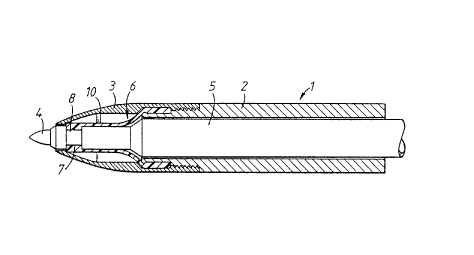Une partie des informations de ce site Web a été fournie par des sources externes. Le gouvernement du Canada n'assume aucune responsabilité concernant la précision, l'actualité ou la fiabilité des informations fournies par les sources externes. Les utilisateurs qui désirent employer cette information devraient consulter directement la source des informations. Le contenu fourni par les sources externes n'est pas assujetti aux exigences sur les langues officielles, la protection des renseignements personnels et l'accessibilité.
L'apparition de différences dans le texte et l'image des Revendications et de l'Abrégé dépend du moment auquel le document est publié. Les textes des Revendications et de l'Abrégé sont affichés :
| (12) Brevet: | (11) CA 2149787 |
|---|---|
| (54) Titre français: | INSTRUMENT DE MARQUAGE |
| (54) Titre anglais: | MARKING INSTRUMENT |
| Statut: | Réputé périmé |
| (51) Classification internationale des brevets (CIB): |
|
|---|---|
| (72) Inventeurs : |
|
| (73) Titulaires : |
|
| (71) Demandeurs : | |
| (74) Agent: | MACRAE & CO. |
| (74) Co-agent: | |
| (45) Délivré: | 1999-02-16 |
| (86) Date de dépôt PCT: | 1994-01-13 |
| (87) Mise à la disponibilité du public: | 1994-07-21 |
| Requête d'examen: | 1995-05-18 |
| Licence disponible: | S.O. |
| (25) Langue des documents déposés: | Anglais |
| Traité de coopération en matière de brevets (PCT): | Oui |
|---|---|
| (86) Numéro de la demande PCT: | PCT/GB1994/000073 |
| (87) Numéro de publication internationale PCT: | WO1994/015799 |
| (85) Entrée nationale: | 1995-05-18 |
| (30) Données de priorité de la demande: | ||||||
|---|---|---|---|---|---|---|
|
Un instrument de marquage, par exemple, un marqueur à pointe en feutre, possède une pointe (4) de marquage rétractable supportée par l'élément marqueur (5) logé dans le cylindre, et une membrane d'enroulement (10) connectée entre l'élément marqueur et le cylindre afin de former une enveloppe hermétique autour de la pointe (4) lorsque celle-ci se rétracte. Au moment où la pointe se rétracte, l'élément marqueur tourne pour enrouler la membrane et fermer l'enveloppe.
A marking instrument, e.g. a felt tip marker, has a retractable marking tip (4) carried by a marker unit (5) housed within the barrel,
and a rolling diaphragm (10) connecting between the marker unit and barrel to form a sealed envelope around the tip (4) when the tip is
retracted. Upon retraction of the tip, the marker unit rotates to twist the diaphragm and close the envelope.
Note : Les revendications sont présentées dans la langue officielle dans laquelle elles ont été soumises.
Note : Les descriptions sont présentées dans la langue officielle dans laquelle elles ont été soumises.

Pour une meilleure compréhension de l'état de la demande ou brevet qui figure sur cette page, la rubrique Mise en garde , et les descriptions de Brevet , États administratifs , Taxes périodiques et Historique des paiements devraient être consultées.
| Titre | Date |
|---|---|
| Date de délivrance prévu | 1999-02-16 |
| (86) Date de dépôt PCT | 1994-01-13 |
| (87) Date de publication PCT | 1994-07-21 |
| (85) Entrée nationale | 1995-05-18 |
| Requête d'examen | 1995-05-18 |
| (45) Délivré | 1999-02-16 |
| Réputé périmé | 2001-01-15 |
Il n'y a pas d'historique d'abandonnement
| Type de taxes | Anniversaire | Échéance | Montant payé | Date payée |
|---|---|---|---|---|
| Le dépôt d'une demande de brevet | 0,00 $ | 1995-05-18 | ||
| Taxe de maintien en état - Demande - nouvelle loi | 2 | 1996-01-15 | 100,00 $ | 1995-05-18 |
| Enregistrement de documents | 0,00 $ | 1996-02-01 | ||
| Taxe de maintien en état - Demande - nouvelle loi | 3 | 1997-01-13 | 100,00 $ | 1996-12-30 |
| Taxe de maintien en état - Demande - nouvelle loi | 4 | 1998-01-20 | 100,00 $ | 1997-12-31 |
| Taxe finale | 300,00 $ | 1998-10-08 | ||
| Taxe de maintien en état - Demande - nouvelle loi | 5 | 1999-01-13 | 150,00 $ | 1999-01-05 |
Les titulaires actuels et antérieures au dossier sont affichés en ordre alphabétique.
| Titulaires actuels au dossier |
|---|
| THE GILLETTE COMPANY |
| Titulaires antérieures au dossier |
|---|
| TALBOT, JOHN MITCHELL |